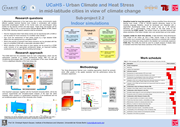Research Module 2.2 Indoor Simulations
General
This sub-project focuses on the development of simulation-based methods for evaluating the heat stress in interiors of buildings in densely populated urban areas. Two essential questions are studied in the core:
- How can detailed statements be made with a manageable computational effort on the heat stress in inner spaces, which are subject to the influence of realistic boundary conditions of a fluctuating outside and inside climate ?
- How must simulation models be designed for a heat-stress analysis in interiors, so that boundary conditions of the building design and of air conditioning technologies can be easily integrated?
A more simplified and therefore faster thermal room model with a much smaller number of balance elements will be developed, based on the modelling language Modelica. Both the simplified room model and a more complex CFD-room model will be integrated with a thermal comfort and heat-stress model of humans to obtain two differently detailed Indoor Climate System Models (ICSM_coarse and ICSM_fine). The fast ICSM_coarse will allow the calculation of unsteady heat-stress scenarios, even over several days. Because of the modular properties of Modelica, the ICSM_coarse can be easily adapted to different room situations and can be connected with the models for building air conditioning. The ICSM_fine will be used for in-depth analysis of heat-stress scenarios.
Collaboration within Research Links (RL)
| 430 | Simulation-based design for rooms and buildings for reducing heat-stress risks |
| 440 | Prospective active A/C-solutions and building design |
Collaboration within Research Cluster (RC)
